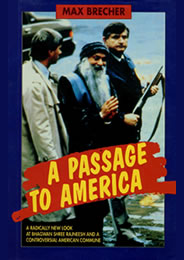My Books
All the books on this site are available in a digital format. After receiving payment we will send them to you via email. Please make sure your server can easily handle the load. GMAIL is best.
 |
A PASSAGE TO AMERICA: A Radically New Look at Bhagwan Shree Rajneesh and a Controversial American Commune
Price: US$ 15 |
Bhagwan Shree Rajneesh (1931-1990) or “Osho” as his sannyasins (disciples) and friends now call him mixed a profound ancient wisdom with a modern sense of fun. For those willing to relax their grip on the steady, safe and “sane” and even let go of it entirely the previously unheard of was not only imaginable, but also hands on possible. Sex with an abundance of fellow travelers and intimacies of the body and heart not previously experienced.
Yet for the majority of those opened up and transformed through contact with Rajneesh and his meditations, any quantity of earthly delights was only foreplay on the way towards something bigger, better and brighter. Blazing like a thousand suns brighter. The ultimate in cosmic consciousness. What he and others have called “enlightenment”.
Rajneesh’s numerous critics had a different tale to tell. They said he was a hi-tech con man who seduced the young and impressionable, the rich and beautiful, and eventually broke them psychologically, spiritually and financially. They claimed that his feel good, morality free philosophy is a threat to society’s sacred and indispensable institutions: marriage, the family, organized religion and civilization itself.
In short, he was a wolf in sheep’s clothing, the devil in a not very good disguise.
For almost two decades, the Indian mystic was a media hot spot, a source of inspiration for many and irritation for more. Then, after his arrest and deportation from the United States in the fall of 1985, he became a black hole on the news map. Even when he was still alive, most thought he was in prison or dead. Who cared?
What had happened? His detractors said the man’s essential corruption had been utterly exposed and his whole approach discredited. His lovers said his being dumped down the memory hole was the result of a US government conspiracy. Hard as it is for some people to imagine and admit, they do that sort of thing.
A PASSAGE TO AMERICA is the first and only book to systematically explore the complex sequence of events that led to Rajneesh’s deportation and the death of a $150 million commune-city in the Oregon desert. Based entirely on historical records and more than a hundred interviews conducted in the United States, Europe and India, it re-examines old misconceptions in the light of new turned up evidence and proves beyond a doubt - reasonable or otherwise that there wasn’t a single conspiracy against the man and his message, but many against both.
It was standing room only conspiracies, not very well organized by numerous state and federal agencies and departments who were often at odds with themselves and each other. And they weren’t just legalistic harassments. “We’ll investigate you until we find something! Anything!” Some were lethal. For example, there were assassination plots.
Why? The intent was to shut down a city and shut up a man threatening business as usual. The historical record, as unearthed and pieced together by the author, clearly indicates that in the minds of many high- middle- and lower- level government officials Rajneesh represented an upsurge of the riotous 1960s, something they wished to prevent or put down at all costs.
A Passage to America proves all that. But its purpose is not to square circles or build bridges across the chasms separating those who would praise Rajneesh and those who would bury him. Or to proselytize for anyone or anything. Rather, the point is to open up for complete re-inspection and assessment yet another of history’s many slammed shut cases. Let readers draw their own conclusions.
Those familiar with the first edition of this volume should know that this is a totally revised work. The stress then was on stop the presses scoop journalism. Here I have delved more into the abundant and high quality academic research on this and related topics and been more generous with the use of footnotes. There are more than 1500 of them.
Without sacrificing rigor and accuracy, I have also opted for a more literary approach. Appropriate rhythms, telling metaphors, and more precisely chosen words. The results are, in my opinion, a stronger, tighter argument and more pleasing peruse.
There’s also a whole new chapter (13), which was originally intended to be a brief appendix on yellow journalism – with particular emphasis on The Oregonian – and then spun out to become the longest chapter in the book. It should be noted that the first 20 pages of that chapter were sent in a slightly different form to about 40 newspapers and television stations in Oregon – including The Oregonian - and not a single one of them deemed it or me worth a response.
So much for the quality of that state’s journalism. At least as far as this theme is concerned.




